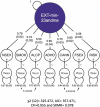This is a preprint.
Guidelines for Evaluating the Comparability of Down-Sampled GWAS Summary Statistics
- PMID: 36993611
- PMCID: PMC10055200
- DOI: 10.1101/2023.03.21.533641
Guidelines for Evaluating the Comparability of Down-Sampled GWAS Summary Statistics
Update in
-
Guidelines for Evaluating the Comparability of Down-Sampled GWAS Summary Statistics.Behav Genet. 2023 Nov;53(5-6):404-415. doi: 10.1007/s10519-023-10152-z. Epub 2023 Sep 15. Behav Genet. 2023. PMID: 37713023 Free PMC article.
Abstract
Proprietary genetic datasets are valuable for boosting the statistical power of genome-wide association studies (GWASs), but their use can restrict investigators from publicly sharing the resulting summary statistics. Although researchers can resort to sharing down-sampled versions that exclude restricted data, down-sampling reduces power and might change the genetic etiology of the phenotype being studied. These problems are further complicated when using multivariate GWAS methods, such as genomic structural equation modeling (Genomic SEM), that model genetic correlations across multiple traits. Here, we propose a systematic approach to assess the comparability of GWAS summary statistics that include versus exclude restricted data. Illustrating this approach with a multivariate GWAS of an externalizing factor, we assessed the impact of down-sampling on (1) the strength of the genetic signal in univariate GWASs, (2) the factor loadings and model fit in multivariate Genomic SEM, (3) the strength of the genetic signal at the factor level, (4) insights from gene-property analyses, (5) the pattern of genetic correlations with other traits, and (6) polygenic score analyses in independent samples. For the externalizing GWAS, down-sampling resulted in a loss of genetic signal and fewer genome-wide significant loci, while the factor loadings and model fit, gene-property analyses, genetic correlations, and polygenic score analyses are robust. Given the importance of data sharing for the advancement of open science, we recommend that investigators who share down-sampled summary statistics report these analyses as accompanying documentation to support other researchers' use of the summary statistics.
Conflict of interest statement
Figures




References
-
- Allen Institute for Brain Science. (2022). BrainSpan: Atlas of the Developing Human Brain. BrainSpan Atlas of the Developing Human Brain. Retrieved 22 December 2022, from http://www.brainspan.org/
-
- Becker J., Burik C. A. P., Goldman G., Wang N., Jayashankar H., Bennett M., Belsky D. W., Karlsson Linnér R., Ahlskog R., Kleinman A., Hinds D. A., Caspi A., Corcoran D. L., Moffitt T. E., Poulton R., Sugden K., Williams B. S., Harris K. M., Steptoe A., … Okbay A. (2021). Resource profile and user guide of the Polygenic Index Repository. Nature Human Behaviour, 5(12), Article 12. 10.1038/s41562-021-01119-3 - DOI - PMC - PubMed
-
- Bucholz K. K., McCutcheon V. V., Agrawal A., Dick D. M., Hesselbrock V. M., Kramer J. R., Kuperman S., Nurnberger J. I., Salvatore J. E., Schuckit M. A., Bierut L. J., Foroud T. M., Chan G., Hesselbrock M., Meyers J. L., Edenberg H. J., & Porjesz B. (2017). Comparison of Parent, Peer, Psychiatric, and Cannabis Use Influences Across Stages of Offspring Alcohol Involvement: Evidence from the COGA Prospective Study. Alcoholism, Clinical and Experimental Research, 41(2), 359–368. 10.1111/acer.13293 - DOI - PMC - PubMed
Publication types
Grants and funding
LinkOut - more resources
Full Text Sources
